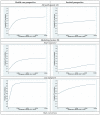Cost-Effectiveness of Prolonged Physical Activity on Prescription in Previously Non-Complying Patients: Impact of Physical Activity Mediators
- PMID: 36900811
- PMCID: PMC10001088
- DOI: 10.3390/ijerph20053801
Cost-Effectiveness of Prolonged Physical Activity on Prescription in Previously Non-Complying Patients: Impact of Physical Activity Mediators
Abstract
In Sweden, physical activity on prescription (PAP) is used to support patients in increasing their levels of physical activity (PA). The role of healthcare professionals in supporting PA behavior change requires optimization in terms of knowledge, quality and organization. This study aims to evaluate the cost-effectiveness of support from a physiotherapist (PT) compared to continued PAP at a healthcare center (HCC) for patients who remained insufficiently active after 6-month PAP treatment at the HCC. The PT strategy was constituted by a higher follow-up frequency as well as by aerobic physical fitness tests. The analysis was based on an RCT with a three-year time horizon, including 190 patients aged 27-77 with metabolic risk factors. The cost per QALY for the PT strategy compared to the HCC strategy was USD 16,771 with a societal perspective (including individual PA expenses, production loss and time cost for exercise, as well as healthcare resource use) and USD 33,450 with a healthcare perspective (including only costs related to healthcare resource use). Assuming a willingness-to-pay of USD 57,000 for a QALY, the probability of cost-effectiveness for the PT strategy was 0.5 for the societal perspective and 0.6 for the healthcare perspective. Subgroup analyses on cost-effectiveness based on individual characteristics regarding enjoyment, expectations and confidence indicated potential in identifying cost-effective strategies based on mediating factors. However, this needs to be further explored. In conclusion, both PT and HCC interventions are similar from a cost-effectiveness perspective, indicating that both strategies are equally valuable in healthcare's range of treatments.
Trial registration: ClinicalTrials.gov NCT03012516.
Keywords: cost-effectiveness; cost–utility; health behavior; mediating factors; metabolic syndrome X; physical; physical therapy specialty; prescriptions; primary healthcare; quality of life.
Conflict of interest statement
The authors declare no conflict of interest.
Figures
Similar articles
-
Long-term physical activity on prescription intervention for patients with insufficient physical activity level-a randomized controlled trial.Trials. 2020 Sep 15;21(1):793. doi: 10.1186/s13063-020-04727-y. Trials. 2020. PMID: 32933577 Free PMC article. Clinical Trial.
-
Cost-effectiveness of neck-specific exercise with or without a behavioral approach versus physical activity prescription in the treatment of chronic whiplash-associated disorders: Analyses of a randomized clinical trial.Medicine (Baltimore). 2017 Jun;96(25):e7274. doi: 10.1097/MD.0000000000007274. Medicine (Baltimore). 2017. PMID: 28640136 Free PMC article. Clinical Trial.
-
Cost-effectiveness of a blended physiotherapy intervention compared to usual physiotherapy in patients with hip and/or knee osteoarthritis: a cluster randomized controlled trial.BMC Public Health. 2018 Aug 31;18(1):1082. doi: 10.1186/s12889-018-5975-7. BMC Public Health. 2018. PMID: 30170586 Free PMC article. Clinical Trial.
-
Multi-gene Pharmacogenomic Testing That Includes Decision-Support Tools to Guide Medication Selection for Major Depression: A Health Technology Assessment.Ont Health Technol Assess Ser. 2021 Aug 12;21(13):1-214. eCollection 2021. Ont Health Technol Assess Ser. 2021. PMID: 34484487 Free PMC article.
-
Reverse Total Shoulder Arthroplasty Is the Most Cost-effective Treatment Strategy for Proximal Humerus Fractures in Older Adults: A Cost-utility Analysis.Clin Orthop Relat Res. 2022 Oct 1;480(10):2013-2026. doi: 10.1097/CORR.0000000000002219. Epub 2022 May 4. Clin Orthop Relat Res. 2022. PMID: 35507306 Free PMC article.
References
-
- Roth G.A., Abate D., Abate K.H., Abay S.M., Abbafati C., Abbasi N., Abbastabar H., Abd-Allah F., Abdela J., Abdelalim A. Global, regional, and national age-sex-specific mortality for 282 causes of death in 195 countries and territories, 1980–2017: A systematic analysis for the Global Burden of Disease Study 2017. Lancet. 2018;392:1736–1788. doi: 10.1016/S0140-6736(18)32203-7. - DOI - PMC - PubMed
-
- Stanaway J.D., Afshin A., Gakidou E., Lim S.S., Abate D., Abate K.H., Abbafati C., Abbasi N., Abbastabar H., Abd-Allah F. Global, regional, and national comparative risk assessment of 84 behavioural, environmental and occupational, and metabolic risks or clusters of risks for 195 countries and territories, 1990–2017: A systematic analysis for the Global Burden of Disease Study 2017. Lancet. 2018;392:1923–1994. - PMC - PubMed
-
- Yrkesföreningar för Fysisk Aktivitet (YFA) Fysisk Aktivitet i Sjukdomsprevention och Sjukdomsbehandling, FYSS 2021. Läkartidningen Förlag AB; Stockholm, Sweden: 2021.
-
- Physical Activity Guidelines Advisory Committee . 2018 Physical Activity Guidelines Advisory Committee Scientific Report. Physical Activity Guidelines Advisory Committee; Washington, DC, USA: 2018.
-
- WHO . Global Action Plan on Physical Activity 2018–2030: More Active People for a Healthier World. World Health Organization; Geneva, Switzerland: 2019.
MeSH terms
Associated data
LinkOut - more resources
Full Text Sources
Medical
Research Materials


